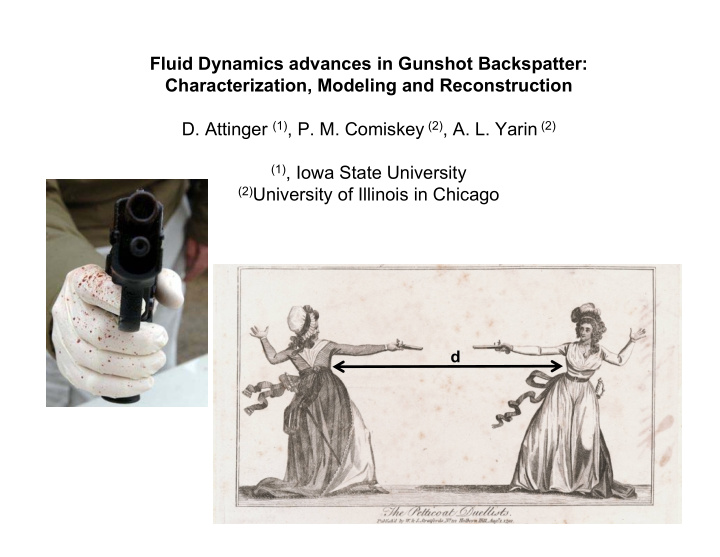



Fluid Dynamics advances in Gunshot Backspatter: Characterization, Modeling and Reconstruction D. Attinger (1) , P. M. Comiskey (2) , A. L. Yarin (2) (1) , Iowa State University (2) University of Illinois in Chicago d
d 2
Characterization: Backspatters are complex pattern 37,000 stains 3
4
5
Proportion Stain diameter [mm] 6
Data of Celestina Rossi, L. Harold et al., “ Cranial Backspattter Pattern Production Utilizing Human Cadavers ”, being finalized for JFS 3193 spots found 926 stains Elapsed time is 17.49 seconds. 7
Characterization of backspatter atomization: the MFRC database by Laber, Epstein and Taylor • Over 150 high-speed videos of common bloodletting mechanisms • Used for BPA training • Described qualitatively in literature • Not yet described quantitatively https://www.ameslab.gov/mfrc/bpa-videos 8
9 7Aa1 .22 cal bullet impacting bloodied sponge
Atomization cone measured from MFRC movies Forward spatter backspatter out out bullet out out 10
bullet Forward spatter Backward spatter out 11 P. M. Comiskey, A. L. Yarin, and D. Attinger, "High-Speed Video Analysis of Forward and Backward Spattered Blood Droplets," Forensic Science International, vol. 276, pp. 134-141, 2017.
Measuring velocities with Particle Image Velocimetry (PIV) W. Thielicke, E.J. Stamhuis, PIVlab-Time Resolved Digital Particle Image Velocimetry Tool for MATLAB (v 1.41), (2014), doi:http://dx.doi.org/10.6084/ m9.figshare.1092508. 12 http://faculty.mccormick.northwestern.edu/richard-lueptow/images/fire-sprinkler.jpg
Characterization: Velocities measured on MFRC movies with PIV Forward spatter 7Aa1: 7Ab1: Backward spatter 13 P. M. Comiskey, A. L. Yarin, and D. Attinger, "High-Speed Video Analysis of Forward and Backward Spattered Blood Droplets," Forensic Science International, vol. 276, pp. 134-141, 2017.
Modeling backspatter atomization V acceleration 2 2R V accelerati on R Rayleigh – Taylor instability breaks accelerated blood into drops when a heavier fluid (blood) is accelerated towards Explosion supernova a lighter fluid (air). 15 https://en.wikipedia.org/wiki/Rayleigh–Taylor_instability
Modeling backspatter atomization (2) • the Rayleigh-Taylor instability determines distribution of droplet diameter d and velocities ������� ������� � ≅ ������� ∙ ����� ������������ • by conservation of linear momentum, the average angle of ejection is estimated 16
Comparison of experiments and modeling (1) Impact angle Modeling (experiments) R + Radial location 17 P. M. Comiskey, A. L. Yarin, and D. Attinger, "High-Speed Video Analysis of Forward and Backward Spattered Blood Droplets," Forensic Science International, vol. 276, pp. 134-141, 2017.
Comparison of experiments and modeling (2) Modeling (experiments) Number of stains r + radial location r, cm 18 P. M. Comiskey, A. L. Yarin, and D. Attinger, "High-Speed Video Analysis of Forward and Backward Spattered Blood Droplets," Forensic Science International, vol. 276, pp. 134-141, 2017.
Relevance to Crime Scene Reconstruction? d=20cm Number of stains d=50cm r + R= function (d) Radial location r, cm d out R 19
Conclusions • A characterization software for spatters can save days of work in evaluating blood spatter • Cone angle and initial velocities of drops in gunshot backspatter were measured • Theoretical model was produced for gunshot backspatter • Theoretical model results are in very good agreement for distribution of impact angles and stain numbers from experiments • Relevance for BPA reconstruction is discussed – I am eager to see more realistic backspatter data P. M. Comiskey, A. L. Yarin, and D. Attinger, "Prediction and Experimental Comparison of a Blunt Bullet Gunshot in Bloodstain Pattern Analysis," Phys Rev Fluids, 2017. 20
Acknowledgements and bibliography: •Iowa State University •US Department of Justice, National Institute of Standards (CSAFE) •Yu Liu, Kris de Brabanter, Ying Xing, Basant Sikarwar, John Polansky, Prashant Agrawal [1] D. Attinger, C. Moore, A. Donaldson, A. Jafari, and H. A. Stone, "Fluid dynamics topics in bloodstain pattern analysis: comparative review and research opportunities," Forensic Sci Int, vol. 231, pp. 375-96, 2013. [2] P. M. Comiskey, A. L. Yarin, and D. Attinger, "Hydrodynamics of back spatter by blunt bullet gunshot with a link to bloodstain pattern analysis," Physical Review Fluids, vol. 2, p. 073906, 2017. [3] T. L. Laber, B. P. Epstein, and M. C. Taylor, "High speed digital video analysis of bloodstain pattern formation from common bloodletting mechanisms," IABPA News, pp. 4-12, 2008. [4] P. Agrawal, L. Barnet, and D. Attinger, "Bloodstains on woven fabric: Simulations and experiments for quantifying the uncertainty on the impact and directional angles," accepted 2017 in Forensic Science International. [5] P. M. Comiskey, A. L. Yarin, and D. Attinger, "High-Speed Video Analysis of Forward and Backward Spattered Blood Droplets," Forensic Science International, vol. 276, pp. 134-141, 2017. [6] Celestina Rossi, L. Harold et al., “Cranial Backspattter Pattern Production Utilizing Human Cadavers”, being finalized for Journal Forensic Sciences [7] P. M. Comiskey, A. L. Yarin, S. Kim, and D. Attinger, "Prediction of blood back spatter from a gunshot in bloodstain pattern analysis," Physical Review Fluids, vol. 1, p. 043201, 2016. 21
Recommend
More recommend